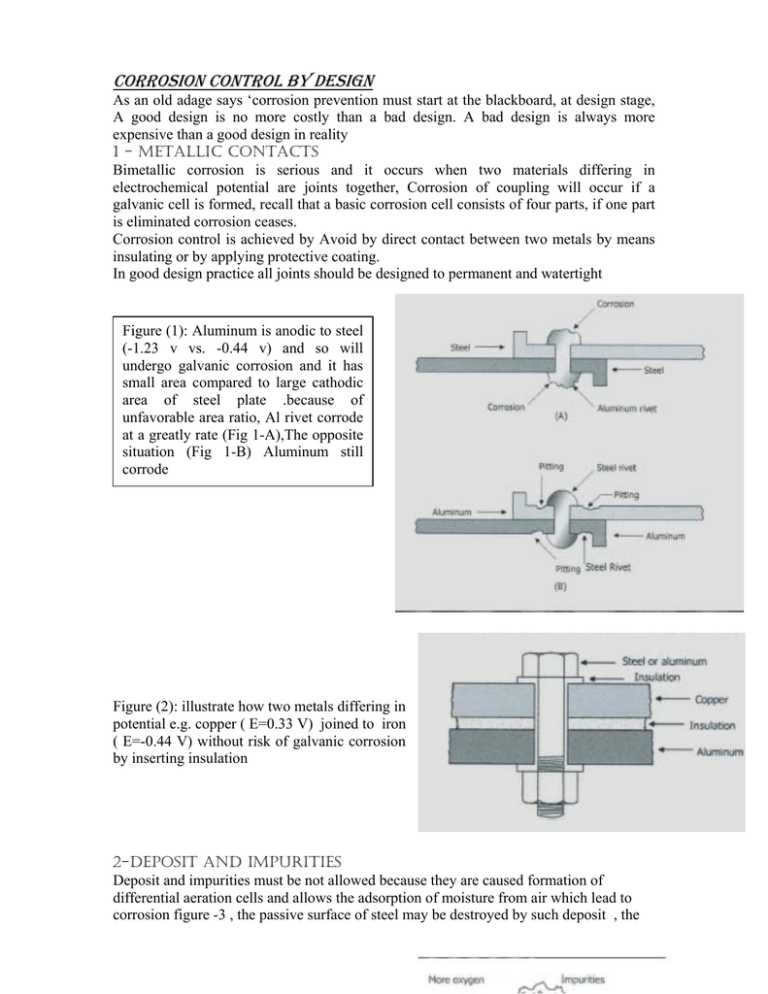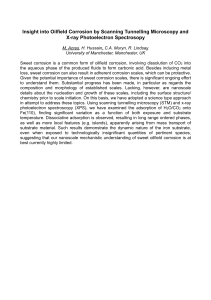CORROSION CONTROL BY DESIGN
advertisement

CORROSION CONTROL BY DESIGN As an old adage says ‘corrosion prevention must start at the blackboard, at design stage, A good design is no more costly than a bad design. A bad design is always more expensive than a good design in reality 1 - METALLIC CONTACTS Bimetallic corrosion is serious and it occurs when two materials differing in electrochemical potential are joints together, Corrosion of coupling will occur if a galvanic cell is formed, recall that a basic corrosion cell consists of four parts, if one part is eliminated corrosion ceases. Corrosion control is achieved by Avoid by direct contact between two metals by means insulating or by applying protective coating. In good design practice all joints should be designed to permanent and watertight Figure (1): Aluminum is anodic to steel (-1.23 v vs. -0.44 v) and so will undergo galvanic corrosion and it has small area compared to large cathodic area of steel plate .because of unfavorable area ratio, Al rivet corrode at a greatly rate (Fig 1-A),The opposite situation (Fig 1-B) Aluminum still corrode Figure (2): illustrate how two metals differing in potential e.g. copper ( E=0.33 V) joined to iron ( E=-0.44 V) without risk of galvanic corrosion by inserting insulation 2-DEPOSIT AND IMPURITIES Deposit and impurities must be not allowed because they are caused formation of differential aeration cells and allows the adsorption of moisture from air which lead to corrosion figure -3 , the passive surface of steel may be destroyed by such deposit , the sites under the deposit become anode and the lead to pitting. Hence, a good design should not allow the built –up of impurities on surface 3-CREVICES Any point at which two metals surfaces are separated by a narrow gap is a possible cell ,moisture enters the gap often in by capillary action , when the liquid is in contact with air , the oxygen is replenished but the centre of the water film becomes impoverished in oxygen and corrosion occur at that point Crevices are formed behind spot-welded overlays or bolt joints under rim of sheet metal which has been folded to give a smooth outer edge , at bolted or riveted joints and at shined or overplayed plates. Some aspects of a good and bad design are shown in figure 4 To minimize crevice corrosion: 1. Use welded joints in preference to bolted or riveted 2. Minimize contacts between metals and non-metals which might cause crevice 3. Avoid sharp corner, edges, and packets 4. Use fillers and mastics to fill any gaps 4-INADEQUATE DRAINAGE AND VENTILATION If light rain or spray falls on a bare steel surface, rings of rust will be found after the water has evaporated. Each droplet acts as a differential-aeration cell and the rust rings develop where iron ions from the anode meet the hydroxyl ions generated on cathode. If the surface is free draining or there is adequate ventilation to dry the water droplets rapidly, the corrosion damages will be limited. Even on paint surface, there will be damage if the droplets persist for long time. Damage increase often found on bottom surfaces of a structure, where the ventilation is likely to be less efficient, because the area is prevailing air currents. All channels and box sections should be free-draining so that water will not sit in the section 5-CONTACT WITH WET INSULATION MATERIALS Insulation materials such as glass wool , glass fiber and polyurethane , do not cause corrosion of steel in contact with them as long as the insulation material remain dry , corrosion underneath insulation , however assumes significant proportions if the insulation becomes wet during storage ,or operation. Following are the factors leading to insulation induced corrosion: 1. Ingress of moisture in insulation resulting in leaching of soluble salts of low pH (about 2-3) 2. Release of chloride ions 3. Destruction of passivity of steel by chloride ions and initiation of pits 4. Weather cycles such as wet-dry , hot-dry and dump-warm cycles with induce high corrosion rate 5. Inadequate moisture barriers because of inadequate spacing of insulation Corrosion induced by insulation can be prevented by following measures 1. Eliminating flat horizontal surface 2. Structural designs which trap water (example Hbeam and channel) 3. Strict compliance of insulation thickness 4. Providing an adequate barrier and waterproofing 5. Addition of sodium silicate as an inhibitor 6-SOLDERING AND THREADING Threaded joints are susceptible to the formation of differential aeration cells thus soldering is preferable .A metal with a more noble potential than the parent material must be used for soldering .bolted joints and threaded joints cannot be always avoided in nonpermanent structure for reasons of assembling and disassembling. However they are used , should be treated for corrosion prevention. Figure show the suitability of soldering over threaded joints, and other figure show comparison of spot welded joints and rivets, the figure also illustrate why welded joints are preferable to recited 7- FLOWING WATER SYSTEM The majority of corrosion problems in flowing water system are caused by obstruction to smooth flow. Turbulence and impingement adversely affect smooth flow conditions and lead to errosion-corrossion attack .one reason for failure are imperfections created at manufacturing stage.To minimize flow-induced corrosion are summarized below Design replaceable parts for the system area which are mostly likely to corrode Select materials which are compatible and do not offer risk of bimetallic corrosion The pipe should be design for a smooth flow and all valves, flanges and other fittings should be installed in accordance with design specifications to allow minimum disturbance to smooth flow. Attack occurs in condenser tubes handling sea water which circulates at high velocity with turbulent flow .The problem can overcome by decreasing the velocity and streamlining the design of pipelines.sharp changes in flow direction must be not allowed. The use of sacrificial baffle plates is effective in minimizing corrosion. Increasing the pipe diameter is another way of reducing velocity and minimizing corrosion in flowing water system Regular maintenance and cleaning of the pipe is important as accumulation of impurities may lead to changes in flow pattern Avoid placing pipes in direct contact with sand , and minimize vibrations by use supporting system 8-TANKS AND PIPE SYSTEM There are several factors to be considered when design tank and pipe systems for the storage or transport of electrolyte. Galvanic and differential-aeration cells may developed because of various constructional materials used or at crevices in joints or behind gaskets Additional problems arise when electrolyte is trapped in the system by badly sited drain taps or poorly designed bends and junctions in the pipes 9-DESIGNS FOR LIQUID CONTAINERS A good design for liquid container must offer the following: a) Freedom from sharp corners and edges. b) Smooth flow of liquid from the container. c) Freedom from the buildup of water traps around the corners. d) Complete drainage from the corners without any water traps. The elimination of water traps is essential to minimize the formation of differential oxygen cells which lead to corrosion. e) Minimizing of bimetallic corrosion by joining compatible materials without the risk of galvanic corrosion. f) Complete internal and external coating of the containers, if cost effective Design should consider mechanical and strength requirement together with an allowance for corrosion .There are many design rules which should be followed for best corrosion resistance these rules are listed below: 1. Weld rather than rivet tanks and other containers 2. Tank bottom should be sloped toward drain holes do that liquid cannot collect after tank is empted 3. Design systems for the easy replacement of components that are expected to fail rapidly in service 4. Avoid electric contact between dissimilar metals 5. Avoid sharp in piping system 6. Avoid hot spots during heat transfer operation (i.e. desired uniform temperature gradient hot spots lead to stress corrosion cracking 7. Design to exclude air 8. The most general rule for design is avoid heterogeneity (i.e. attempt to make all conditions as uniform as possible throughout the entire system. CORROSION CONTROL BY MATERIAL SELECTION Corrosion may be minimized by employed an appropriate design as discussed , on the other hand the selection of appropriate materials in a given environments is a key for corrosion control strategy the following table shows the contribution of corrosion resistance to be the process of material selection Cost Availability Material properties • Raw material • Quantity • Production cost • weld ability • formability • mach inability •Labor requirements • anticipated service life • made to order • bough from manufacture • available “off the shelf” • tooling required • mechanical ( hardness , fatigue , creep , shear , impact and etc.) •Physical properties( density , electrical and magnetic, thermal conductivity , and etc..) •Chemical properties ( corrosion resistance ) Correct Material selection






